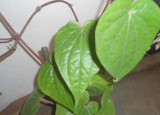Betel Leaf

The betel leaf, also called as paan ka patta (Hindi), is used in all important Hindu festivals and occasions. It is a simple leaf, yet comes with powerful health benefits and is also an important ingredient in the Ayurveda. Betel leaf is native to South-East Asia and is considered as important as the Tulasi leaf.
If you have been to a Hindu traditional wedding, you would have noticed that betel leaf is eaten after a meal and is said to aid digestion after a heavy wedding meal (kalyana saapadu).
Betel leaves are put in the ‘Kalasha’ or holy pot when performing rituals and pooja during festivals. Two betel leaves are offered to guests coming home, along with betel nut and coins as a tradition. This is called as ‘Thambool’. Betel leaf is said to purify water and is a sign of health and prosperity.
As per Hindu beliefs, various gods and goddesses reside on different parts of the heart-shaped leaf.
It is also believed that in Ramayana, when Lord Hanuman conveys Sri Rama’s message to Sita Devi, she gives him a garland of betel leaves as a mark of joy and appreciation.
The combination of Betel leaves and Areca nut symbolize loyalty and strong bond in marriages, and thus to impart good luck, these are consumed during the marriage talks.
Apart from its religious significance, Betel leaf is said to have lot of health benefits. It contains Fiber, Vitamin C, Vitamin A, Calcium, Potassium, Iodine, thiamine, niacin and many other essential nutrients. Consumption of betel leaves in limited quantities aids in cough, treating nosebleed and bleeding gums, treating acne, and curing bronchitis. Betel leaves have immune-boosting and anti-cancer properties.
© Symbols.com
